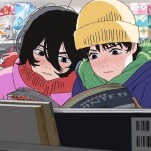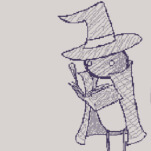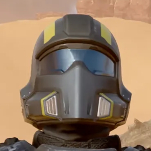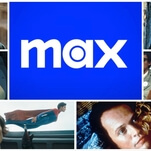“Shoots-y and kids-y” is the way one PR rep on the show floor summed up last week’s Electronic Entertainment Expo. If you’re unfamiliar, E3 is the annual trade show in which the titans of the mainstream game industry proclaim that they are on the cutting edge of art, thought, and the world. Then they dump out a wheelbarrow full of predictable genre standards. Prime among those standards this year was the first-person shooter. Motion-controlled kids’ games came in a close second.
The dominance of the shooter is hardly a recent development, but guns were so prevalent at the show this year that even a general in the Michigan Militia would find the industry’s firearm obsession a little over-the-top. And while there will likely be plenty of worthwhile entertainment to be found in games like Battlefield 3 and Modern Warfare 3, it’s troubling that the gaming industry of a nation involved in three intractable military conflicts has almost nothing more profound to say about present-day warfare than “Now you can customize your gun with voice commands!”
A Microsoft vice president claimed with a straight face that the people making games like this on the Xbox 360 are “the world’s best storytellers.” But fetishization of war isn’t the same as a meaningful exploration of war, and the industry’s biggest budgets are dedicated to the former.
Publishers are doubling down on shooters because the console market is getting squeezed by the increasing success of newer gaming venues—most notably Facebook and the iTunes App Store—and war games tend to top the charts more reliably than other fare. It’s a doubly vicious cycle. As studios increase their focus on shooters, each one gets a smaller sliver of the console pie, and the resulting homogeneity on store shelves shrinks the target audience further.
The industry has latched on to one possible savior: motion control. Nintendo’s Wii and Microsoft’s Kinect have sold very well, and Sony’s PlayStation Move also exists. The enticing part for publishers’ accounting departments is that these products are often purchased by people who haven’t traditionally taken to console gaming (read: women and older people). The trouble is coming up with compelling games to keep these new players interested.
The results are rarely inspiring. On the Kinect as with the Wii, there looks to be a huge amount of low-production-value chaff in the kiddie pool. And even where there’s a promising project like Double Fine’s Sesame Street: Once Upon A Monster, we’re still talking about games that are of primary interest to the under-6 set, hardly the pop-cultural revolution that the console makers would like to ignite.
Of course, hyper-commercial, conservative E3 is the last place anyone should look for a revolution. Not much there is truly new. The best you can realistically hope for is new-ish. But hey, new-ish can still be pretty cool. In spite of the industry’s troubles on the whole, there are still plenty of smart, inventive people working in mainstream games, and a lot of them show up to present their ideas at E3. Below are 20 notable games and gadgets from E3 2011—10 sequels and 10 debuts. This isn’t an exhaustive list of newsworthy games from the show. Rather, it’s a sampling of flotsam that stood out amid the wash of marketing noise.
Assassin’s Creed: Revelations
Platforms: PC, PlayStation 3, Xbox 360
Projected release: November 2011
(Note: All platforms and release dates are subject to change.)
Revelations is the fourth Assassin’s Creed game for home consoles, but really, it’s the third Assassin’s Creed II game. When publishers love a game, they make it a trilogy, and Ubisoft loved Assassin’s Creed II very much. (With good reason, given what an improvement it was over its predecessor.) In this sequel to a spin-off to a sequel, the action shifts to Constantinople, as Ezio Auditore, the James Bond of the Renaissance, continues his quest to sleep with and/or murder the entire population of Europe.
The old: Ezio’s old. He’s aged considerably since his debut in Assassin’s Creed II. Miraculously, he’s as agile as ever. The only tangible change is a little more gray in his beard. But there’s no doubt that even with those salt-and-pepper whiskers, Ezio’s “good friend” Leonardo Da Vinci finds the hunk of Italian man-meat as delicious as ever.
The new-ish: The stealthy, precise assassin now augments his weaponry with an assortment of super-powerful explosives. Okay, sure.
Batman: Arkham City
Platforms: PC, PlayStation 3, Wii U, Xbox 360
Projected release: October 2011 for current platforms; 2012 for Wii U
Shortly after the Dark Knight’s victory in Batman: Arkham Asylum, Gotham’s mayor hatches a plan to turn half the city into one big prison. For whatever reason—maybe somebody messed up the paperwork—this does not go well. Thus the Caped Crusader must biff and pow Joker & Friends into submission again. A PR flack on the show floor claimed that Batman’s fighting style has been “enhanced” with a bunch of new moves and animations, but the hand-to-hand combat still had the same smooth, approachable kineticism as before.
The old: Catwoman is a fresh face for this series of Batman games, but in the scenes on display at E3, her campy characterization was positively musty, hearkening back to the Eartha Kitt days.
The new-ish: Batman can now launch himself into the air with a grappling hook and glide around the landscape, a fun technique lifted from the underappreciated Just Cause 2.
Brothers In Arms: Furious 4
Platforms: PC, PlayStation 3, Xbox 360
Projected release: 2012
All anyone needs to know about Gearbox Software’s Brothers In Arms: Furious 4 is that its trailer concludes with a Nazi on a toilet. Easily the dumbest-looking game at E3, Furious 4 is a complete departure from earlier, more reverent Brother In Arms titles. Featuring a band of four kra-zee characters who are out to dismantle the Third Reich one ball-busting brawl at a time, Furious 4 combines Inglourious Basterds, The Village People, and the guy at work who emails you YouTube clips of that Kenny Vs. Spenny episode where they compete to see who can fart the loudest. It’s impossible to tell whether the game will be clever-stupid or just stupid-stupid, but stupid-stupid might be more amusing anyway.
The old: It’s still a World War II shooter, so Gearbox isn’t exactly upturning the gaming industry’s checkers board here.
The new-ish: The game features a Native American character who plants tomahawks in Nazi faces, continuing a trend Assassin’s Creed ignited, with people getting sharp objects driven into their skulls. Stabbing someone in the face: When shooting someone in the face just isn’t violent enough.
Dark Souls
Platforms: PlayStation 3, Xbox 360
Projected release: October 2011
For legal reasons, publisher Namco Bandai refers to Dark Souls only as the “spiritual successor” to Demon’s Souls, but make no mistake, this is a direct follow-up to From Software’s much-beloved 2009 fantasy action game. The visuals are more polished in Dark Souls, and players have a more diverse selection of character types, but Demon’s Souls’ difficulty and inscrutable quietness remain, as does its brilliant mix of single-player loneliness and online collaboration. (Not to mention online antagonism.)
The old: Players will still be able to post messages for each other on the landscape of the game world, a quaint pen-pal feature invented for Demon’s Souls. Broadening the communication bandwidth a bit, the sequel will let you place a beacon that invites other players to enter your world so they can help you get past an especially tough spot.
The new-ish: A character class called the Pyromancer has the ability to make difficult enemies spawn in other players’ game sessions, expanding Dark Souls’ appeal to the highly coveted “jerk” market.
The Elder Scrolls V: Skyrim
Platforms: PC, PlayStation 3, Xbox 360
Projected release: November 2011
Dark Souls is a big deal, but it’s still a cult hit. With its widely respected Bethesda Softworks pedigree, Skyrim is the most anticipated RPG of the year. The Elder Scrolls IV: Oblivion has aged well in some ways, as it’s still a rich fantasy world with a ton of fun, small stories to explore. But it’s built on a rickety software foundation, and it has some, shall we say, visual shortcomings. (For instance, you’d think in a cast of thousands, there’d be at least one person who wasn’t drop-dead ugly, but no.) Skyrim looks far sleeker than Oblivion. It’s gorgeous. But graphical improvements are to be expected, as are most of the incremental innovations that publisher/developer Bethesda has divulged so far.
The old: The E3 demo spent a lot of time focusing on the huge amount of damage a player can wreak with added battle features like double-fisted spellcasting, but that’s silly. “Massive damage” is relative, and the game’s combat will be finely balanced, as it always has been in Elder Scrolls games. You will have to work hard to gain an advantage.
The new-ish: Skyrim will have dialogue recorded by more than 70 voice actors, as compared to Oblivion’s “We just grabbed a couple of dudes—and oh yeah, Patrick Stewart had a few lines.”
Far Cry 3
Platforms: PC, PlayStation 3, Xbox 360
Projected release: 2012
Far Cry 2 was a marked break from the game that preceded it. The sequel ditched Far Cry’s space-alien storyline and invited players to explore its world—a war-torn African nation—more freely than the original ever did. It was better that way, and Far Cry 3 tries to keep a good thing going. It follows the model of Far Cry 2. One difference is the tropical-island setting, which is reminiscent of the original game. Also, judging by the E3 gameplay demo, there’s now this crazy guy who says “fuck” a lot, so, you know, edgier.
The old: You play as Jason Brody, a guy looking for his girlfriend on an island of genocidal madmen. You might think that if you’re going up against ethnic cleansing, Far Cry 3 would have enough dramatic tension without throwing in the ol’ “rescue the princess” number. You’d be wrong.
The new-ish: Brody carries a camera, so photography may play a big part in the game. Will this satisfy the legion of fans demanding a sequel to the similarly camera-happy Beyond Good And Evil? No. Their thirst will never be slaked. They will wander the desert for centuries, re-telling tales of the pig-man and the girl with the green lipstick, until memory itself comes to an end.
Mass Effect 3
Platforms: PC, PlayStation 3, Xbox 360
Projected release: March 2012
Judged in light of this game’s huge potential—Mass Effect was reasonably good, and Mass Effect 2 was The A.V. Club’s top game of 2010—the Mass Effect 3 demo was the most disappointing on the show floor. It was awful. The low point was a scene shown at the end of the presentation. Attendees were warned beforehand that this sequence would pack an emotional wallop. It showed the hero of the series, Commander Shepard, trying to save a boy from an alien invasion. Put it this way: If the scene were submitted to the Hallmark Channel as a treatment for a Christmas special, it would be rejected with the note “Too hokey.”
The old: The sad-little-boy sequence was the worst of the demo, but the rest was almost as bad, as director Casey Hudson prattled on about combat features like mêlée assassinations and hand grenades as if they were exciting innovations, rather than mundane third-person-shooter staples that gamers have seen countless times before.
The new-ish: The traditional Mass Effect dialogue wheel remains, but with Mass Effect 3, if you have a Kinect, you can yell your dialogue choices at the TV rather than using the controller. Jesus Christ, BioWare. Please do not screw this game up.
Prey 2
Platforms: PC, PlayStation 3, Xbox 360
Projected release: 2012
The Prey 2 demo over in Bethesda’s booth was as much of a pleasant surprise as Mass Effect 3 was a letdown. The sequel to a novel-but-forgettable shooter released in 2006, Prey 2 casts the player as a bounty hunter in a dense, futuristic urban world. The Prey 2 setpieces presented to attendees were uniformly exciting, especially a Mirror’s Edge-like chase sequence in which the player hunted down a bounty with the annoying ability to teleport short distances.
The old: The Blade Runner aesthetic has long been a touchpoint for games, and Prey 2 does it well. So does another upcoming science-fiction game, Deus Ex: Human Revolution, but the difference with Prey 2 is that its city environs have a layered, almost deciduous verticality.
The new-ish: You aren’t the prey anymore in Prey 2; you’re the predator. That means Prey 2 will be the first game in history whose title sort of doesn’t make sense.
Tomb Raider
Platforms: PC, PlayStation 3, Xbox 360
Projected release: 2012
The reveal of the Tomb Raider reboot at the Microsoft press conference was a six-minute demo featuring a younger, whinier version of the original, tough Lara Croft. New Lara was at various points bound, impaled, and slammed to the ground. On occasion, snarling men grabbed her legs from behind and flipped her onto her back as she flailed. Lara moaned and whimpered through the whole ordeal. It was like a grueling scene from Law & Order: Special Victims Unit, except that at the end, the audience was expected to applaud. And indeed, a basketball arena filled with media and gaming insiders, at least 90 percent of them men, whooped and clapped. But no, this industry doesn’t have a gender problem. Why do you ask?
The old: It’s hard to look past the embarrassingly unserious “wiggle the joystick to fend off sexual assault” moments, but there is more to the game. Naturally, Tomb Raider reprises the spatial puzzle-solving that is the series’ bread and butter. One wrinkle in this reboot is that Lara can make the key elements of a puzzle glow in the dark because she’s got such great “survival instincts.” It’s like the magic-sunglasses feature from Heavy Rain, except with even thinner narrative justification.
The new-ish: Hey, redesigned pants.
Uncharted 3: Drake’s Deception
Platform: PlayStation 3
Projected release: November 2011
Uncharted is not the cleverest boy at the debutante ball, but hot damn does it look good in a suit, so who cares? This is the production-values game, a sparkling achievement of visual escapism that invites you to look around, take care of some bad guys in summer-blockbuster fashion, and then be lulled into a pleasant daze by the familiar Hollywood-bullshit charms of Drake’s boilerplate personality. The designers of Uncharted 3 will tinker with the formula not one bit. Why would they? Naughty Dog is extremely good at what it does, which is making games that critics describe as “cinematic.”
The old: Uncharted 3 will become yet another Sony-published game featuring stereoscopic 3-D support, which makes for a real nice logo on the front of the box.
The new-ish: This adventure will be set at least partly in the desert. Creative lead Amy Hennig claims that Naughty Dog wanted to confront the challenge of rendering sand with computer animation. That’s right, sand as a selling point. Sounds ridiculous, but the most obnoxious part is that, knowing Naughty Dog, the sand in Uncharted 3 will indeed be pretty sweet.
DEBUTS
Asura’s Wrath
Platforms: PlayStation 3, Xbox 360
Projected release: Unannounced
One of the most intriguing demos at the show was Asura’s Wrath, a bombastic action game made up mostly of playable cutscenes. Asura is a quasi-Hindu cyborg demigod (obviously) out for revenge against a league of gods who spurned him. Judging by the snippets revealed so far, each scene in Asura’s Wrath will be the climax to every science-fiction anime movie ever made, with titanic rage, cosmos-spanning brawls, and lasers. Players have nominal control of Asura for much of this madness, but their task is specific and limited at any given time—shoot down a wave of incoming missiles, say, or toss an angry god into the sky.
The old: Wrath is heavy on “quick-time events,” in which you press a button when an onscreen prompt tells you to push a button. It’s time for these to go away.
The new-ish: Cutscenes are often viewed as the tedious buzz-killers of gaming, so it’s rare to see a title that embraces them so wholeheartedly as Asura’s Wrath. It’s a different sense of player agency than gamers might be used to, and “different” holds some allure. Then again, even in the space of a 10-minute hands-on demo, the novelty started to wear off.
Bastion
Platform: Xbox 360
Projected release: August 2011
The buzz around Warner Bros.’ booth wasn’t so much about Batman: Arkham City—which seems to be exactly what anyone expected—but about Bastion, the gorgeous action RPG due out on Xbox Live Arcade later this year. The game was developed by SuperGiant Games, which is only a seven-person team. With a colorful, hand-painted look, Bastion features a protagonist known only as The Kid; he’s trying to regain some vestige of normality in an crumbling, untethered dream-world that reassembles itself beneath his feet as he forges ahead into the ether.
The old: Bastion’s familiar play style is the latest indication that the tenets of the Diablo-clone format—“2.5-D” perspective, frantic mêlée combat, and so on—haven’t evolved much since Diablo came out 15 years ago. Yet the format still feels fresh and fun, a testament to how great Diablo really was.
The new-ish: Bastion finds cute ways to tell its story. For instance, a grizzled voice, reminiscent of Sam Elliott, narrates your actions as you play. That isn’t as annoying as it sounds. With striking visuals and a keen sense of humor, Bastion may be this year’s Deathspank.
Journey
Platform: PlayStation 3
Projected release: 2011
Like Uncharted 3, Journey has a lot of sand. The similarities end there. Conceived by the developers at Thatgamecompany—most notably Flower co-creator Jenova Chen—Journey is the anti-Uncharted, a game meant to be as un-formulaic as possible. You play a wanderer in the desert. It seems like you ought to head for a mountain in the distance. And as far as the designers are concerned, that is all you need to know.
The old: Like Flower, Journey is atmospheric and beautiful. It tells its story with minimalist visual and aural touches, and the characters’ movement is light and airy. While Journey is not a sequel, Chen is fast developing a signature style.
The new-ish: Although the game includes online multiplayer, your playing companions will not be identified, and you won’t be able to speak to each other. Your vocabulary is limited to a heavenly pulse of sound. Racial slurs don’t yet exist in this binary language, but expect XBLA trolls to invent some.
Lord Of The Rings: War In The North
Platforms: PC, PlayStation 3, Xbox 360
Projected release: August 2011
Lord Of The Rings games are consistently great at one thing, which is being terrible. The people at Snowblind Studios who are working on War In The North say that this time is different, which of course is the same claim made by all those who came before them. Here’s why Snowblind’s devs say that no, really, this time is different: They have the rights to both the LOTR literature and the movies—which is a first in games—and this supposedly allows them to build on the lore in ways that previous, legally handcuffed projects could not.
The old: Set in the same time span as the LOTR trilogy, War In The North focuses on a quest to take down one of Sauron’s right-hand men, which has a very Dragon Age feel. There are only a few obvious directions to go with dwarves, elves, and orcs, and this is one of them.
The new-ish: War In The North can be played alone in Dragon Age fashion, with a computer AI controlling the other members of your noble squadron, but it also works as an online multiplayer game with up to three people.
Overstrike
Platforms: PlayStation 3, Xbox 360
Projected release: Unannounced
A team of four gadget-laden military specialists infiltrate an organization of evil terrorists with evil robots. Details are sketchy beyond that, as Overstrike showed up at E3 2011 with a three-minute trailer and nothing more. The preview, which features gruff squad leader Dalton Burke gruffly giving a gruff interview, garnered attention for its touches of humor. “Kimball’s a pacifist,” says Burke. “Like a Buddhist monk.” This remark is followed by a video clip in which Kimball is actually rather belligerent. Therefore, comedy.
The old: Burke has a scar across his face, which has become universal shooter shorthand for “This guy has a complex backstory, presumably.”
The new-ish: This is the first time developer Insomniac Games will release a title on a non-Sony console. To mark the occasion, the studio appears to be merging the puckish sensibility of its Ratchet & Clank series with the more shoots-y fare of its Resistance games. Is the trailer corny? Yes. But so are the Ratchet & Clank games at first blush, and their comedic rhythm tends to grow on players. In conclusion: Who knows?
PlayStation Vita
Projected release: Late 2011
The PSVita is the handheld console you would expect from bitter Sony engineers who have watched other devices sap the PSP’s mojo over the past few years. “You want touchpads like the iPhone? Fine, have two of them, front AND back. You want dual joysticks? Here you go. Now shut up about it already.” The device also features a compass, a gyroscope, front and rear cameras, 3G cellular connectivity, Bluetooth, and—in a classic Sony move—yet another proprietary memory-card format for its games. Sony believes that if they just make the specification sheet long enough, then maybe people will love them.
The old: The parade of ports and rehashes of existing properties is already underway, including Uncharted: Golden Abyss. In this Nathan Drake romp, players can use the touchscreen to “paint” the landscape and watch as Drake navigates their intended path, saving them the hassle of actually playing the game.
The new-ish: Another upcoming PSVita title, Sound Shapes, is a cross between a platformer and a music-composition game. It looks nifty, and together with the Move-enabled Pixeljunk lifelike on the PS3, it’s part of a mini-boom of song-creation software on Sony’s consoles.
Ruin
Platforms: PlayStation 3, PSVita
Projected release: Unannounced
Sony’s modus operandi is to invent new features for its hardware, then throw money at software developers until they grudgingly find some way to use those features. Ruin is a run-of-the-mill multiplayer dungeon-crawler. Its one novelty is that you can transfer your gameplay session from your PS3 to the PSVita and continue playing on the road, picking up where you left off.
The old: Remember that business about how Bastion makes the Diablo model feel like it’s still vibrant? Yeah. Ruin doesn’t do that.
The new-ish: Although touch controls weren’t in evidence on the E3 build, Ruin’s developers claim it will use the PSVita’s touchpad in one way or another. Sounds promising!
Skulls Of The Shogun
Platforms: PC, Xbox 360
Projected release: 2011
There’s a showcase for independent developers at E3 called IndieCade, and it’s an odd place. It occupies prime real estate in the L.A. Convention Center, yet there are no elaborate light shows or badass tunes blasting from speakers. It’s a dozen PCs or so on a bunch of desks, an oasis in the din of the show floor. The highlight of this year’s IndieCade was Skulls Of The Shogun, a turn-based battlefield game in the spirit of Advance Wars and Final Fantasy Tactics.
The old: The designers say that their art style is inspired by mid-20th-century anime, and Skulls is populated by a goofy mix of animal ghosts and undead samurai warriors. If that’s what mid-20th-century anime is like, maybe it’s time for a comeback.
The new-ish: Unlike FF Tactics and its kin, Skulls doesn’t use a movement grid. Instead, units travel and attack in any direction they please.
Star Wars: The Old Republic
Platform: PC
Projected release: 2011
BioWare’s booth demo of their long-anticipated MMO got off to a bizarre start as the presenters screened a re-cut montage of previously released trailers. Some of the footage in the video was years old. It can’t be a good sign that in a 15-minute preview of the most expensive project ever funded by juggernaut publisher EA, BioWare felt the need to include a couple minutes of filler.
The old: BioWare showed off The Old Reublic’s “moral choice” mechanic with the crustiest good-or-evil moment in the book: “Should he live or should he die?” In the demo, after winning a lightsaber duel, the player had to choose whether to finish off the defeated Sith Lord or let him go. Spoiler: Killing him was the “evil” choice.
The new-ish: Two-way conversation between the player and non-player characters, à la Mass Effect, presents a design challenge for a multiplayer game. At a speech prompt, which of the players in your party decides what to say next? The Old Republic navigates this problem by rolling virtual dice; the winner of the roll chooses the next line of dialogue. Of course, this opens the door for a rhetorical Leeroy Jenkins to upend your careful diplomacy.
Wii U
Projected release: 2012
Nintendo divulged just enough information about its next-generation console to leave everyone confused about how the thing works. We can at least gather that there are two parts to the Wii U. First, there’s the console itself. The new box is capable of sending high-definition images straight to your TV, a technique pioneered by Microsoft a mere six years ago. The console communicates with a new controller—Nintendo annoyingly refers to it only as The New Controller—which has a built-in touchscreen.
Think of the Wii U as the Nintendo DS for your television. While it seemed strange at first, the second screen on the DS ended up serving a variety of functions, depending on the game. Likewise, developers are likely to discover a number of uses for the New Controller’s second screen, whether it simply serves as a place to put extra menus or acts as an augmented-reality “window” that you can move around to explore your in-game surroundings.
The old: Nintendo didn’t announce any games of their own for the Wii U, instead touting commitments from outside developers who will bring their shopworn wares to the new machine. EA will produce a new Madden for the console, as they have for every electronic device in history, and Capcom will churn out a couple thousand Resident Evil games.
The new-ish: Although nobody from Nintendo would confirm this, it looks like the Wii U will only be able to handle one New Controller at a time. For multiplayer games, everybody else will have to use the familiar Wiimote. Yet Nintendo may use this limitation to their advantage. At their E3 booth, they presented a neat five-player prototype game called Chase Mii. The player with the New Controller took on the role of Mario, and everyone else played as toadstool guys chasing Mario around a maze. The object was for any of the Toads to grab fleeing Mario before time ran out. Team Toadstool had the advantage of numbers, but the Mario player had a bird’s-eye view of the entire maze on his New Controller. Great fun ensued. That type of information imbalance is only possible with the Wii U’s auxiliary screen; Chase Mii provided a taste of how Nintendo might exploit this unusual platform.








































